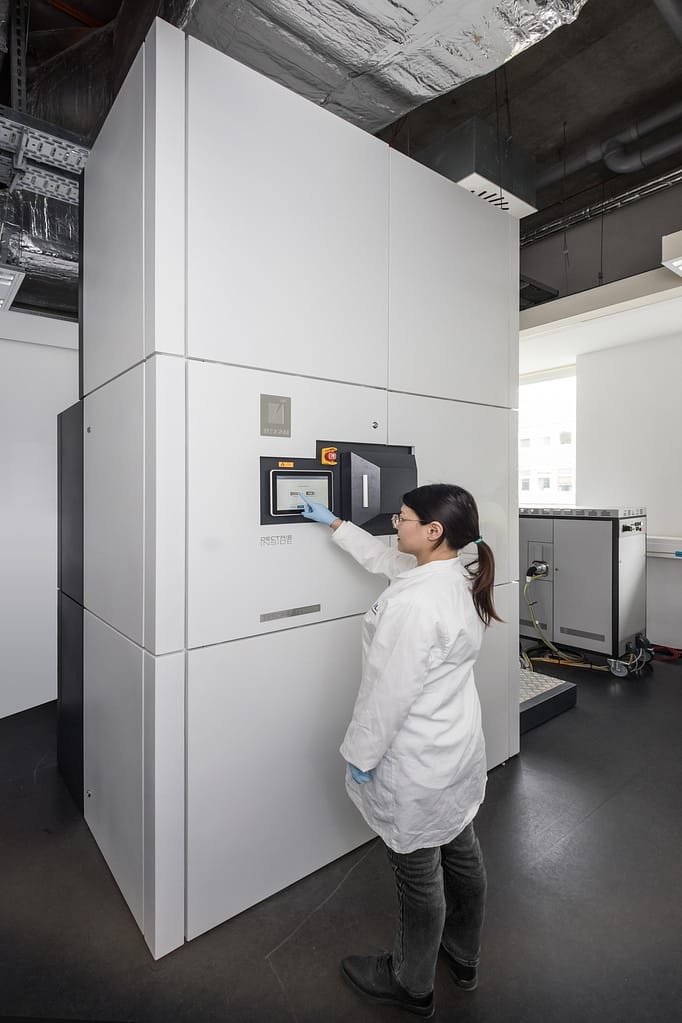Tescan Tensor STEM

The Tescan Tensor STEM is an integrated analytical precession-assisted 4D-STEM instrument for multimodal characterization of nanoscale morphological, chemical, structural and crystallographic properties of a wide range of materials systems. It is equipped with a Schottky field emission electron source, fast electrostatic beam blanker (1 MHz) and precession unit (72 kHz), symmetrical window-less dual EDS detector (2 srad solid angle), and a hybrid-pixel direct electron detector (Dectris Quadro). The column is fully bakeable and can reach UHV condition after baking to eliminate specimen contamination during the measurements. The measurements are automated and further supported by near-real-time data analysis in the Tescan Explore software, while it is also possible to develop custom workflows using the Python-based Tescan ExpertPI library and to export the data compatible with third-party open-access software packages, such as LiberTEM, HyperSpy, py4DSTEM. This is the world’s first Tensor STEM system delivered to customers based on a beta collaboration program between the ER-C and Tescan Orsay Holding.
Sample Environment
The Tescan Tensor STEM currently only supports samples to be studied at room temperature but new specimen holders for cooling, heating, biasing, etc., are being considered for development.
Typical Applications and Limitations of Use
Typical applications:
- BF and ADF STEM imaging
- EDS composition analysis and elemental mapping
- Precession-assisted crystallography orientation and phase mapping
- Precession-assisted strain mapping
- General (precession-assisted) 4D STEM measurements for virtual STEM imaging, differential phase contrast, ptychography, etc, which can optionally be acquired with EDS analysis simultaneously.
- STEM image tomography (coming soon)
- EDS tomography (coming soon)
- 3D electron diffraction (coming soon)
Limitations:
Currently the instrument is not suitable for atomic resolution imaging and doesn’t operate in magnetic-field-free condition.
Specimen Holders
| Single tilt tomography holder | ± 89 ° |
| Double tilt holder | ± 35 ° alpha tilt, ± 25 ° beta tilt |
Detectors
| Tescan Dual 100 mm2 window-less silicon-drift EDS detectors, 2 srad solid angle |
| Tescan BF and HAADF STEM detectors, fastest pixel dwell time 40 ns. |
| Dectris Quadro hybrid-pixel direct electron detectors, 512 x 512 pixels, 2250 frame rate at 16 bit and 4500 frame rate at 8 bit. |
Technical Specifications
| Acceleration voltage | 100 kV (possibly at lower voltages) |
| STEM resolution @ 100 kV | 0.28 nm |
| Vacuum level in sample area | 10-8 Pa after baking, high 10-7 to low 10-6 Pa during daily operation |
| EDS solid angle | 2 srad |
| Beam blanking rate | 1 MHz |
| Beam precession rate | 72 kHz |
| Detector frame rate | 2.25 kHz (16 bit) or 4.5 kHz (8-bit) |
Instrument related Publications
| Dirk van der Wal, Scanning Transmission Electron Microscopy Done Right, Microscopy Today, 31, 15-17 (2023) https://doi.org/10.1093/mictod/qaad009 |
